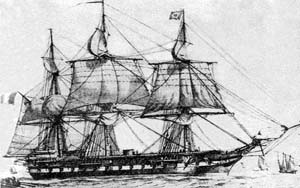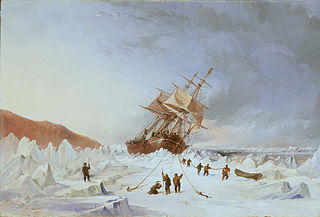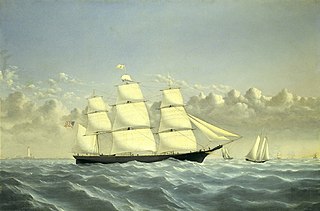
BAP Apurímac was the second steam frigate of the Peruvian Navy, built in England in 1855 along with the steam schooners Loa and Tumbes as a part of a major build-up of the Navy during the government of President José Rufino Echenique. A veteran of two wars and many internal conflicts, due to her age she served as training ship in Callao port from 1873 until January 17, 1881, when she was scuttled along with the rest of the Peruvian Navy to prevent capture by Chilean troops who had occupied the port after the defeat of the Peruvian Army in the battles of San Juan and Miraflores.

HMS Assistance was an Arctic discovery barque of the Royal Navy, and the sixth vessel to carry the name. She began in 1834 as the India-built merchant vessel Acorn. Her name was changed to Baboo. Under that name she transported contract labourers between Mauritius and India, and immigrants to South Australia. The Royal Navy purchased her in 1850 and named her HMS Assistance. Assistance participated in two Arctic expeditions before her crew abandoned her in the ice in 1854.

Golden West was an 1852 extreme clipper built by Paul Curtis. The ship had a very active career in the California trade, the guano trade, the coolie trade, the Far East, and Australia. She made a record passage between Japan and San Francisco in 1856.
Marchioness was a brigantine built at Waterford, Ireland in 1851 and registered at Melbourne that sailed between Nelson, New Zealand and Melbourne, Australia in the 1850s. It foundered on rocks off the Taranaki coast in 1864 and was lost with no loss of life, having previously grounded twice, once off the coast of Victoria, Australia, and once in Cook Strait.
Matoaka was a 1092-ton wooden New Brunswick full-rigged ship built in 1853 for Willis, Gunn, & Co. She was sold to Shaw, Savill, & Albion by 1859. Between 1859 and 1869 she made eight voyages to New Zealand. Her fastest run from Bristol to Lyttelton, New Zealand was 82 days in 1862. On 13 May 1869 she left Lyttelton for London under Captain Alfred Stevens with 45 passengers and 32 crew but was never seen again. In 1865 she was classed as 1322 tons.
Asia was a merchant ship launched at Calcutta in 1815 for Charles Hackett. She made four voyages transporting convicts from Great Britain to Australia, and two voyages under charter to the British East India Company (EIC) between 1826-1830. She was hulked or broken up c.1860.
Hooghly was a full-rigged merchant ship built on the Thames, England, and launched in 1819. She made two voyages under charter to the British East India Company (EIC), four voyages transporting convicts from England and Ireland to Australia, as well as voyages transporting emigrants to South Australia between 1839 and 1856. Around 1858 she was re-rigged as a barque. She sank off Algiers in 1863.

The New Zealand Company was a 19th-century English company that played a key role in the colonisation of New Zealand. The company was formed to carry out the principles of systematic colonisation devised by Edward Gibbon Wakefield, who envisaged the creation of a new-model English society in the southern hemisphere. Under Wakefield's model, the colony would attract capitalists who would then have a ready supply of labour—migrant labourers who could not initially afford to be property owners, but who would have the expectation of one day buying land with their savings.
Fairlie was launched at Calcutta in 1810 and sailed to England. There she became a regular ship for the British East India Company (EIC). Including her voyage to England, she made four voyages for the EIC. From around 1821 on she became a Free Trader, continuing to trade with India under a license from the EIC. She also made two voyages transporting convicts to New South Wales (1834), and Tasmania (1852). She made several voyages carrying immigrants to South Australia, New South Wales, and British Guiana. She foundered in November 1865.
Bombay was launched in 1801 at Daman/Demaun. Her early career is obscure. From 1821 on she assumed Calcutta registry. Between 1832 and 1840 she made three voyages from London as a whaler. In 1842 she carried settlers for the New Zealand Company. She was last listed in 1853.
Regalia was launched at Sunderland in 1811. In 1819 she made a voyage to Calcutta, sailing under a license from the British East India Company (EIC). She also sailed to New South Wales and Van Diemen's Land. From Sydney she engaged in several sealing hunting voyages to the waters around Macquarie Island. In 1826 she transported convicts from Dublin to New South Wales. From 1831 until 1852, when she was wrecked at Davis Strait, Regalia was a whaler in the northern whale fishery.
Glenbervie was launched at Glasgow in 1815. Initially she was a constant trader between Greenock and Demerara. In 1839 the New Zealand Shipping Company chartered her to carry supplies to support immigration to New Zealand. In the 1840s and 1850s she traded more widely, sailing to Australia, the Caribbean, and South America. A fire destroyed her in August 1860.
Lord Hungerford was launched at Calcutta in 1814. Her most notable voyages were one transporting convicts to Van Diemen's Land and two for the British East India Company. Later she brought laborers to British Guiana and immigrants to Victoria and South Australia. She foundered on 1 June 1861 on her way to Valparaiso to be converted to a coal hulk.
Princess Charlotte was a ship launched in Sunderland in 1813. She immediately started trading with the Indian Ocean and India under a license from the British East India Company (EIC). She made one voyage for the EIC, and she made two voyages transporting convicts to Australia, one to Hobart Town, Van Diemen's Land, and one to Port Jackson, New South Wales. She foundered in 1828 in the Bay of Bengal.
Prince of Orange was launched in Sunderland in 1814. She originally sailed as a West Indiaman but then became an East Indiaman, sailing to India under a license from the British East India Company (EIC). She made two voyages transporting convicts to Australia, the first in 1820–1821 to New South Wales, and the second in 1822 to Van Diemen's Land. Between 1830 and 1840 she made nine voyages as a whaler to Davis Strait. She was lengthened and rebuilt in 1846. In December 1852 she grounded and it took some months to get her off. She then need major repairs. She also suffered damages in 1854. She foundered in 1858.
Westmoreland was a ship launched at Hull in 1817. She sailed to India under a license from the British East India Company (EIC). Next, she sailed to Australia with passengers. From Sydney she visited New Zealand, Tahiti, and Valparaiso, before returning to England. She then traded widely, to Russia, North America, West Africa, and India again. She was condemned at Saint Helena on 29 October 1845 as she was returning from the coast of Africa.
Harriet was launched at Calcutta, between 1793 and 1795. Between 1795 and 1801 she made three voyages for the British East India Company (EIC), and was chartered for use as a transport for a naval campaign that was cancelled. She became a transport and then in 1817 made another voyage to India, this time under a license from the EIC. She then became a whaler in the British Southern Whale Fishery, making seven complete whaling voyages and being lost c.1841 on her eighth.
Star was built in Calcutta in 1800. Between 1803 and 1811 she made three seal hunting voyages. From 1812 she sailed as a merchantman until she was wrecked on 18 December 1829 on a voyage to Jamaica.
Several ships have been named Roehampton for Roehampton:
Grand Sachem was launched at Newburyport, Massachusetts in 1801. She was registered at Bideford in 1803, but until 1815 sailed from Milford Haven. Between approximately 1803 and 1822, she made eight voyages as a whaler in the British southern whale fishery. She was last listed in 1822 and was broken up in 1826.



